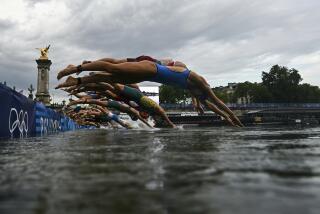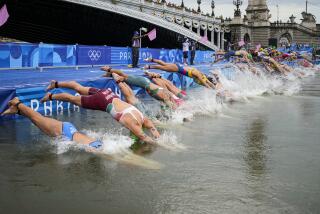San Diego International Triathlon : Improving Triathlete Larson Is Used to Coming From Behind
- Share via
SAN DIEGO — Jay Larson has always found himself trying to catch up for lost time, and his latest athletic endeavor is a microcosm of his competitive life.
In Sunday’s San Diego International Triathlon, which begins at 7 a.m., he may just be the guy the “name” competitors have on their heels in the stretch run . . . if he does not fall too far behind in the swimming segment at the start.
“I think if I keep up on the swim, I’ll be in contention,” said Larson, who lives in La Jolla, waits tables three days a week and also coaches track at the Bishop’s School. “If I get off on the run right near the lead, I know I can outrun anybody out there. That’s my goal, to keep up so I get to the run in time (to be competitive).”
The event begins with a one-kilometer swim off Spanish Landing. From there, the athletes will bike 30 kilometers to Cabrillo Monument and back and run 10 kilometers along Harbor Drive to the finish at Seaport Village.
It is not too surprising that Larson has settled upon a sport that is really three in one. He was a three-sport athlete in high school, went to college on a baseball scholarship, made a brief attempt at professional baseball and a stronger one at pro golf and is now making his strongest attempt yet . . . as a triathlete.
His strength is the run. His weakness is the swim, and that’s where the favorites, such as defending champion Brad Kearns, Scott Tinley and Andrew MacNaughton expect to put themselves minutes ahead
“Jay loses time in the swim that he can’t afford to lose,” said Murphy Reinschreiber, who is vice president for Inclyne Sports promotion company and who has been involved with triathlons for 13 years.
One of the reasons Larson has yet to achieve balance as a triathlete is that he has been competing for only three years. He has some catching up to do.
Larson is 32, an age when most triathletes are preparing for the end of their careers. He’s still enjoying the beginning.
Still, catching up isn’t something foreign to him. His baseball scholarship was at Loyola Marymount University, but he missed his senior season because of a freak hand injury he suffered while working construction for his father. At 22, he tried to gain a free agent tryout with the Dodgers and Angels.
“They asked how old I was,” he said. “I said 22, and they said, ‘We don’t look at anyone over 21.’ ”
So then it was golf, and within a year, he shot a 69.
“I thought, ‘Shoot, this game is easy,’ ” he said. “Boy, was I mistaken.”
He said that in 1982, less than three years after he took up the sport, he missed qualifying for the L.A. Open by a shot as an amateur.
“I’m glad I missed, because I wasn’t prepared to do that,” he said. “I would have gagged it real bad. It was kind of one of those things where you play over your head too soon.”
He said he played in mini-tour events filled with college-age players who had been playing half their lives.
“There was so much pressure to get good fast, and I was always behind,” Larson said. “Here I was 25, 26 years old, just starting out. I was the oldest guy in the tournament with the least amount of experience.”
He contemplated quitting golf for a year before he finally put his clubs in the closet.
“I realized I didn’t love it enough,” Larson said. “I realized that I didn’t want to make the sacrifice that I was going to have to make and wait until I was 33 or 34 years old to make it on the tour.”
The triathlon was next.
“I had been watching this sport for a number of years,” he said. “I was fascinated by the Ironman and Dave Scott and Scott Tinley and all those guys. I saw them out there running on the lava pits and I just thought, ‘I could do that.’ ”
He bought a $400 bike and headed north to live with his brother and train in Seattle.
Seattle? Not a haven for training.
“I didn’t get much done,” he said. “It was too cold and rainy.”
His father, who was finishing up a construction project in San Diego, offered his son a place to stay and work out.
“I had never done any swimming,” Larson said. “I thought, ‘Gosh, if I could swim just a mile a day, I could get in really good shape.’ I heard about (UC San Diego’s) pool and all those top guys were there. I started off in the slowest lane in the pool. I had heard stuff on TV about how Scott Tinley couldn’t swim, how he was slow. He was going by me like I wasn’t moving. I thought ‘Oh my God, what have I got myself into?’ ”
But after six months, he placed 30th out of 800 competitors in his first triathlon.
“I thought, ‘Well, I got a lot of time to improve,’ ” he said. “And I thought, ‘My God, this really hurts.’ ”
He was talking pain, something he never really understood when he used high school cross-country as a secondary sport to stay in shape for basketball and baseball at Pacific High School in San Bernardino.
“When I started this sport, I realized I was never in shape when I was doing this in high school, because when you’re a high school kid you don’t know anything,” Larson said. “A couple weeks before the season starts, you go out and run, and then you race. It takes a year to get in good shape, if that. I didn’t really realize that at the time, and that’s one of the reasons I didn’t go out and run, because I thought, ‘This hurts way too much.’ Why would anyone want to go through this kind of pain?”
Twenty months after he began training, he encountered the ultimate in triathlon pain--the Ironman (a 2.4-mile swim, 112-mile bike ride and 26.2-mile run). But Larson was ready, and he finished 11th overall. That was part of a very good 1986 season, in which he also won the Huntington Beach Triathlon. But success threw off his training.
“I screwed up my second full year pretty bad,” he said. “I got a little overzealous after coming in 11th. I started training like an absolute madman. I wasn’t eating properly, and I didn’t replace my calories well enough. I started to break down pretty badly.”
He suffered back problems that cut his bike training in half. He started getting treatment and missed three months.
But recently, he has been making progress. He won the non-invitational division of the Carlsbad 5,000, beating out fellow triathlete Mark Allen, also an excellent runner. And at the recent Triprix, he placed 21st out of 100 competitors in one of the best men’s fields ever assembled.
“(In the) Triprix, I was really pleased because I had a really, really cruddy swim,” he said. “I was roughly four minutes behind right off the bat, and part of that is inexperience in the ocean. That was the first time I had ridden the bike without pain (since his 1987 back injury).”
Given good health, he may be ready for a breakthrough.
“I think the guy’s wonderfully talented,” Reinschreiber said. “You watch him train, and he seems to have all the tools, but he hasn’t had that big race that makes a career for him.”
The International Triathlon may be that race for Larson.
“I’ve only raced 17, 18 times,” he said. “I consider myself a beginner. If I move up one more notch, I will make money.”


